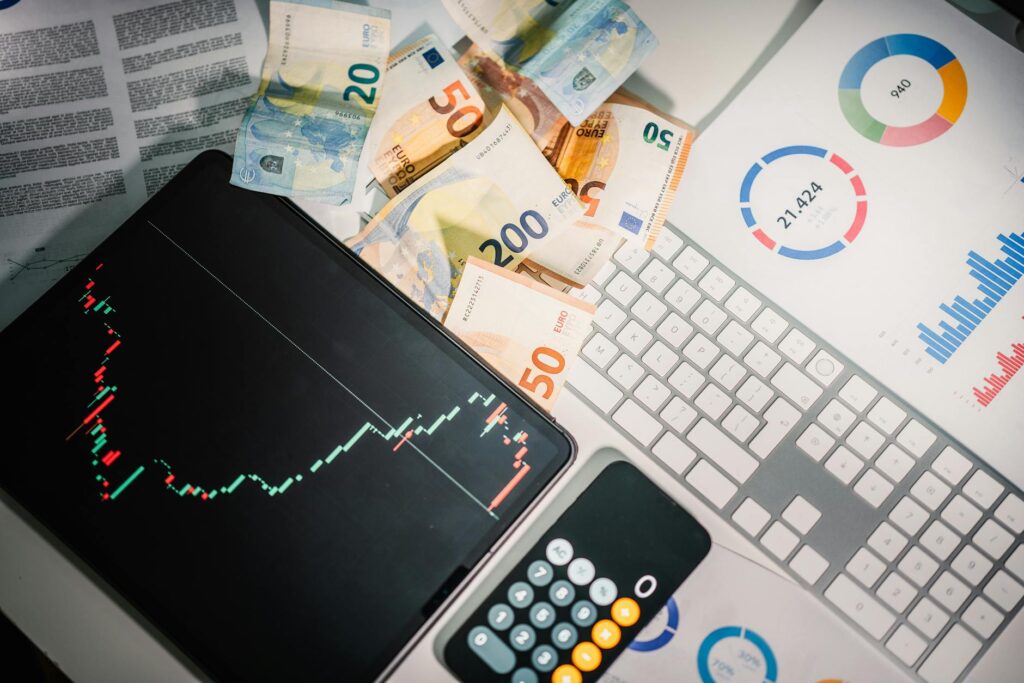The Puppeteers of Your Portfolio: How Central Banks Influence Stocks and Crypto
Ever feel like the markets have a mind of their own? One day it’s all green arrows and rocket emojis, the next it’s a sea of red. While a million factors are at play, some of the biggest strings are pulled from behind the curtains of the world’s financial institutions. We’re talking about the incredible impact of central bank policies on everything you invest in, from your blue-chip stocks to your volatile crypto holdings. It’s a topic that sounds incredibly complex, maybe even a little boring, but I promise you, understanding it is one of the most powerful tools you can have as an investor. It’s the difference between reacting to the news and anticipating the market’s next big move.
For a long time, these two worlds—traditional finance and the burgeoning crypto space—seemed galaxies apart. Stocks were for suits on Wall Street, and crypto was for cypherpunks and digital pioneers. But the lines have blurred. Dramatically. Now, when the head of the Federal Reserve clears his throat, both traders in New York and crypto enthusiasts in Singapore lean in to listen. Why? Because the decisions they make about money supply and interest rates create ripples, and sometimes tsunamis, that crash upon the shores of every market. Let’s break down how this all works, without the jargon and a lot more real-talk.
First, Who Are These Central Banks Anyway?
Think of a central bank as the financial mothership for a country or a group of countries. In the United States, it’s the Federal Reserve (the Fed). In Europe, it’s the European Central Bank (ECB). Their main job is to keep the economy stable. Not too hot (runaway inflation), not too cold (a recession). They have a toolkit they use to manage this delicate balancing act, and two tools are more important than any others for us investors:
- Interest Rates: This is the big one. It’s essentially the cost of borrowing money. When the central bank raises rates, it becomes more expensive for businesses to expand and for you to get a loan. When they lower rates, borrowing becomes cheaper, encouraging spending and investment.
- Quantitative Easing (QE) & Quantitative Tightening (QT): This sounds way more complicated than it is. QE is basically the central bank “printing” new money to buy government bonds and other assets. This injects cash into the financial system, pushing asset prices up. QT is the exact opposite; they sell assets and effectively remove money from the system, which tends to have a cooling effect.
These actions set the overall ‘mood’ for the market. They control the flow of money, and as we all know, money is what makes the markets go ’round.

The Classic Dance: How Central Bank Policies and Stocks Interact
The relationship between central banks and the stock market is a well-rehearsed dance. For decades, investors have followed a simple mantra: “Don’t fight the Fed.” When a central bank is in a ‘dovish’ or ‘accommodative’ mood (meaning low interest rates and QE), it’s like a green light for the stock market.
Why does this happen? Let’s unpack it.
The Era of ‘Easy Money’
When interest rates are near zero, a few things happen simultaneously:
- Borrowing is Cheap: Companies can borrow money for next to nothing to invest in new projects, hire more people, and buy back their own stock. All of these things are generally great for their bottom line and stock price.
- Bonds Look Boring: If a super-safe government bond is only paying you 1% interest, are you really going to put your money there? Probably not. You’ll look for better returns elsewhere. This pushes investors towards riskier assets, like stocks. This is called the ‘TINA’ effect – There Is No Alternative.
- Future Earnings Look Better: In finance, a company’s future earnings are valued based on a ‘discount rate’, which is heavily influenced by interest rates. Low rates mean future profits are worth more today, justifying higher stock prices, especially for growth-oriented tech companies.
The period from 2009 to 2021 was a masterclass in this. Central banks kept the money spigots wide open, and the stock market went on one of the longest bull runs in history. It wasn’t a coincidence.
When the Music Stops: The ‘Hawkish’ Turn
But what happens when the economy gets too hot and inflation starts to rear its ugly head? The central bank has to step in and be the ‘bad guy’. They become ‘hawkish’, raising interest rates and sometimes engaging in QT. Everything we just discussed goes into reverse.
- Corporate borrowing gets expensive, squeezing profit margins.
- Suddenly, that ‘safe’ government bond paying 5% looks a lot more attractive than a volatile stock. Money flows out of stocks and into bonds.
- Future earnings are discounted at a higher rate, making stocks (especially those high-flying tech stocks with profits far in the future) look overvalued.
We saw this play out in spectacular fashion in 2022. The Fed jacked up interest rates at a historic pace to fight inflation, and both the S&P 500 and the Nasdaq took a massive hit. The dance is predictable, but the steps can be painful.
Crypto’s Crash Course in Macroeconomics
For its first decade, the crypto world largely ignored central banks. Bitcoin was born out of the 2008 financial crisis, created as a direct response to the perceived failures of central banking and the QE experiment. The whole idea was to create a decentralized, non-governmental form of money with a fixed supply that couldn’t be manipulated. It was supposed to be the ultimate inflation hedge, the digital gold.
And for a while, it seemed to march to the beat of its own drum. But as crypto became more mainstream, with institutional investors and hedge funds piling in, something changed. Crypto assets, especially Bitcoin and Ethereum, started moving in lockstep with the most speculative parts of the stock market, like the tech-heavy Nasdaq index.
The moment institutional money flooded into crypto, it stopped being just a niche tech experiment and became another ‘risk asset’ on the global balance sheet. That means it’s now subject to the same macroeconomic forces as everything else.
When central banks were printing money during the pandemic (peak QE), where did a lot of that excess cash go? It went into stocks, real estate, and yes, a massive amount went into crypto, fueling the explosive 2021 bull run. Crypto wasn’t acting as an inflation hedge; it was acting as a primary beneficiary of asset inflation created by central bank policy.
Then came 2022. When the Fed turned hawkish and started raising rates, the ‘risk-off’ sentiment was brutal. Investors dumped their riskiest assets first to raise cash and reduce exposure. What’s riskier than unprofitable tech stocks? For many, it’s crypto. The correlation became undeniable. As the Fed tightened, the crypto market experienced one of its most severe bear markets ever.
So, Are Stocks and Crypto Just the Same Thing Now?
Not exactly. While they are both dancing to the tune of the central banks, they have different choreographies. The correlation is strong, but it’s not perfect, and the nuances are important.
Similarities in Reaction:
- Risk Appetite: Both are seen as ‘risk-on’ assets. When money is cheap and confidence is high, money flows into both. When fear takes over and money gets tight, money flows out.
- Liquidity Driven: Both markets have been heavily influenced by the sheer amount of liquidity (cash) pumped into the system by central banks. When the tide of liquidity goes out, all boats—whether they’re a tech stock or a token—go down.
Key Differences:
- Intrinsic Value vs. Network Value: A stock’s value is (in theory) tied to a company’s earnings, assets, and cash flow. Crypto’s value is derived from its network effect, security, utility, and a shared belief in its future potential. This can lead to different long-term drivers.
- Volatility Levels: Crypto is still the Wild West. Its volatility is orders of magnitude higher than even the most speculative stocks. A bad day for the S&P 500 might be -3%. A bad day for Bitcoin could be -15%, and for smaller altcoins, it could be -50%.
- The Halving Cycle: Bitcoin has its own internal monetary policy—the halving. Every four years, the reward for mining new bitcoin is cut in half, reducing its inflation rate. This supply-side shock is a massive driver of crypto cycles that is completely independent of the Fed.

What’s an Investor to Do? Navigating the New Landscape
Okay, so central banks are the puppet masters. What does this mean for your strategy? It doesn’t mean you should panic-sell every time a Fed official sneezes. But it does mean you can’t afford to ignore the macro environment anymore, whether you’re a stock purist or a crypto diehard.
Pay Attention to the Data: Start tracking key economic indicators that central banks watch. The big one is the Consumer Price Index (CPI), which measures inflation. Also, keep an eye on jobs reports. Strong jobs and high inflation often mean the central bank will need to raise rates or keep them high. Weak jobs and low inflation give them room to cut rates.
Understand the Narrative: Listen to what central bankers are saying in their speeches and press conferences. Are they using ‘hawkish’ language (concerned about inflation) or ‘dovish’ language (concerned about growth)? The market hangs on their every word, and the narrative they set can move prices for months.
Diversify, But Be Smart About It: The old advice of diversifying between stocks and bonds still holds. But understand that in a ‘risk-off’ environment driven by central bank tightening, your crypto might not be the uncorrelated diversifier you thought it was. It may act more like a super-charged tech stock. Your real diversifiers in that scenario might be cash, short-term bonds, or commodities like gold.
Conclusion
The game has changed. The wall between the traditional financial system and the crypto ecosystem has crumbled. The policies enacted in Washington, Frankfurt, and Tokyo now directly and powerfully influence the price of both Apple stock and Dogecoin. While crypto’s long-term vision of a separate, decentralized financial system is still alive, its short-to-medium-term price action is undeniably tied to the flow of cheap money controlled by central banks. Recognizing this connection is no longer optional for a savvy investor. It’s the key to understanding the powerful currents that move the entire ocean of global markets, allowing you to navigate the waves instead of being swept away by them.


